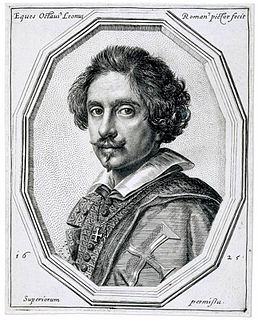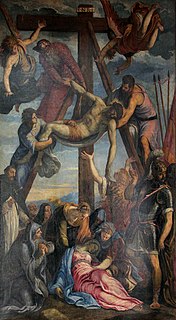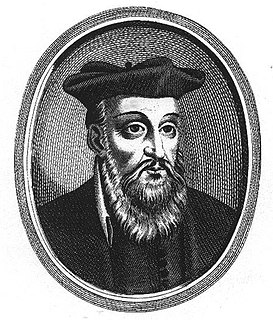Related Research Articles

Andrea di Cione di Arcangelo, better known as Orcagna, was an Italian painter, sculptor, and architect active in Florence. He worked as a consultant at the Florence Cathedral and supervised the construction of the facade at the Orvieto Cathedral. His Strozzi Altarpiece (1354–57) is noted as defining a new role for Christ as a source of Catholic doctrine and papal authority.

Francesco Bartolozzi was an Italian engraver, whose most productive period was spent in London. He is noted for popularizing the "crayon" method of engraving.

CarloDolci was an Italian painter of the Baroque period, active mainly in Florence, known for highly finished religious pictures, often repeated in many versions.

Santi di Tito was one of the most influential and leading Italian painters of the proto-Baroque style – what is sometimes referred to as "Counter-Maniera" or Counter-Mannerism.

The Descent from the Cross, or Deposition of Christ, is the scene, as depicted in art, from the Gospels' accounts of Joseph of Arimathea and Nicodemus taking Christ down from the cross after his crucifixion. In Byzantine art the topic became popular in the 9th century, and in the West from the 10th century. The Descent from the Cross is the 13th Station of the Cross, and is also the sixth of the Seven Sorrows of the Blessed Virgin Mary.

Ottavio Leoni (1578–1630) was an Italian painter and printmaker of the early-Baroque, active mainly in Rome.

The Madonna della Seggiola or The Madonna della Sedia is an oil on panel Madonna painting by the High Italian Renaissance artist Raphael, executed c. 1513–1514, and housed at the Palazzo Pitti Collection in Florence, Italy. Although there is documentation on its arrival to its current location, Palazzo Pitti, it is still unknown who commissioned the painting; however, it has been in the Medici family since the 16th century.

Marcello Venusti was an Italian Mannerist painter active in Rome in the mid-16th century.

Giovanni Battista Bolognini (1611–1688) was an Italian painter and engraver of the Baroque.

Giuseppe Porta (1520–1575), also known as Giuseppe Salviati, was an Italian painter of the late-Renaissance period, active mostly in Venice.
Francesco Ruviali was an Italian painter of the Renaissance period.

Domenico Maria Bonavera was an Italian engraver. He was born in Bologna. He trained in engraving with his uncle Domenico Maria Canuti. His plates are chiefly etched and finished with the dry point. He engraved eighteen plates from the designs of Titian, for a textbook of anatomy. He completed prints depicting: The Baptism of Christ after Albani; St. Anne teaching the Virgin Mary to read, St. Theresa with the Infant Jesus, and a Martyrdom of St. Christiana after Canuti; a St. John preaching after Ludovico Carracci; Lot and his Daughters after Annibale Carracci; The Assumption fresco at the Cupola of the Duomo of Parma (1697); after Correggio

Schelte a Bolswert (1586–1659) was a leading Dutch engraver, noted for his works after Rubens and Van Dyck.

Jean Boulanger, a French line-engraver, son of the painter Olivier Boulanger and cousin to the painter of the same name, was born at Amiens in 1608 and baptized in Troyes in Champagne on 24 January 1608; he had five children with Marie Judon. He was documented in Paris in 1645 and resided in the parish of Saint-Etienne-du-Mont.

Paulus Pontius was a Flemish engraver and painter. He was one of the leading engravers connected with the workshop of Peter Paul Rubens. After Rubens' death, Pontus worked with other leading Antwerp painters such as Anthony van Dyck and Jacob Jordaens.

Georg Jakob Felsing was a German line-engraver.
Antonio Lorenzini (1655–1740) was an Italian painter and engraver of the Baroque, active in his native Bologna, as well as in Florence. He was also called the Frate Antonio. He was a pupil of Lorenzo Pasinelli. It is said that while engraving works in the church of San Francesco in Bologna, specifically the canvas by Pasinelli, where St Anthony of Padua liberates the soul of his father from Purgatory, Lorenzini was inspired to become a Franciscan.

The Florence Cistercians Crucifixion is a circa 1495 fresco of the Crucifixion of Christ by Perugino in the chapter house of the Cistercian monastery of Santa Maria Maddalena dei Pazzi in Florence. It is his most notable work in Florence, forming part of the sacred conversation style. It was a commission from the Pucci family - Antonio Billi's account book reports Dionigi and Giovanna Pucci commissioning a work from "Master Piero della Pieve a Chastello, a Perugian" on 20 November 1493 and paying 55 gold ducats on its completion on 20 April 1496.

Victor Florence Pollet (1811–1882) was a French history painter, watercolourist, and burin engraver.
References
- ↑ Slater, John Herbert (1891). Engravings and Their Value: A Guide for the Print Collector. L. Upcott Gill. p. 453 . Retrieved 19 May 2017.
- ↑ Bryan, Michael (1889). Walter Armstrong; Robert Edmund Graves (eds.). Dictionary of Painters and Engravers, Biographical and Critical. Vol. II L-Z. London: George Bell and Sons. p. 739.